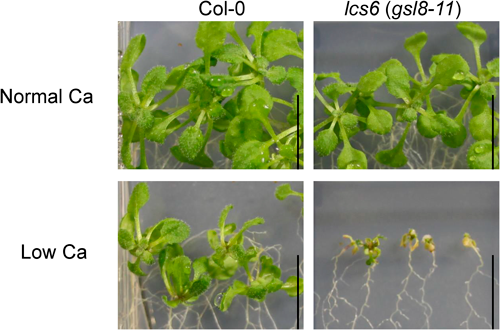- 著者
- Yusuke Shikanai Mayu Asada Takafumi Sato Yusuke Enomoto Mutsumi Yamagami Katsushi Yamaguchi Shuji Shigenobu Takehiro Kamiya Toru Fujiwara
- 出版者
- Japanese Society for Plant Biotechnology
- 雑誌
- Plant Biotechnology (ISSN:13424580)
- 巻号頁・発行日
- vol.39, no.3, pp.221-227, 2022-09-25 (Released:2022-09-25)
- 参考文献数
- 25
- 被引用文献数
- 3
Calcium (Ca) deficiency affects the yields and quality of agricultural products. Susceptibility to Ca deficiency varies among crops and cultivars; however, its genetic basis remains largely unknown. Genes required for low Ca tolerance in Arabidopsis thaliana have been identified. In this study, we identified a novel gene required for low Ca tolerance in A. thaliana. We isolated a mutant sensitive to low Ca concentrations and identified Glucan synthase-like (GSL) 8 as a gene responsible for low Ca tolerance. GSL8 is a paralog of the previously identified low Ca tolerance gene GSL10, which encodes β-1,3 glucan(callose) synthase. Under low Ca conditions, the shoot growth of gsl8 mutants were inhibited compared to wild-type plants. A grafting experiment indicated that the shoot, but not root, genotype was important for the shoot growth phenotype. The ectopic accumulation of callose under low Ca conditions was reduced in gsl8 mutants. We further investigated the interaction between GSL8 and GSL10 by testing the gsl8 gsl10 double mutant for sensitivity to low Ca concentrations. The double mutant exhibited a more severe phenotype than the single mutant under 0.3 mM Ca, indicating additive effects of GSL8 and GSL10 with respect to low Ca tolerance. These results establish that GSL genes are required for low Ca tolerance in A. thaliana.
1 0 0 0 OA Root shape adaptation to mechanical stress derived from unidirectional vibrations in Populus nigra
- 著者
- Marcel Pascal Beier Satoru Tsugawa Taku Demura Toru Fujiwara
- 出版者
- Japanese Society for Plant Biotechnology
- 雑誌
- Plant Biotechnology (ISSN:13424580)
- 巻号頁・発行日
- vol.37, no.4, pp.423-428, 2020-12-25 (Released:2020-12-25)
- 参考文献数
- 25
- 被引用文献数
- 1 4
While it is known that plant roots can change their shapes to the stress direction, it remains unclear if the root orientation can change as a means for mechanical reinforcement. When stress in form of a unidirectional vibration is applied to cuttings of Populus nigra for 5 min a day over a period of 20 days, the root system architecture changes. The contribution of roots with a diameter larger than 0.04 cm increases, while the allocation to roots smaller than 0.03 cm decreases. In addition to the root diameter allocation, the root orientation in the stem proximity was analyzed by appearance and with a nematic tensor analysis in an attempt to calculate the average root orientation. The significant different allocation to roots with a larger diameter, and the tendency of roots to align in the vicinity of the stress axis (not significantly different), are indicating a mechanical reinforcement to cope with the received strain. This work indicates an adaptive root system architecture and a possible adaptive root orientation for mechanical reinforcement.
1 0 0 0 IR バレーボールのゲーム分析 : サーブの落下点とサーブレシーブの成功率に関する研究
- 著者
- 藤原 徹 Toru FUJIWARA 仙台大学 SENDAI COLLEGE
- 出版者
- 仙台大学学術会
- 雑誌
- 仙台大学紀要 = Bulletin of Sendai College (ISSN:03893073)
- 巻号頁・発行日
- vol.19, pp.15-21, 1987-10-01
サーブとサーブレシーブは,バレーボールにおいて最も重要な基本技術のひとつである。本研究は,東北地区大学バレーボール・リーグ戦において,サーブの落下地域とそのサーブレシーブの成功率とが勝敗との関係において,どのように関連しているのかを検討した。そして,その結果をもとにしてサーブレシーブの成功率の悪ゾーン,つまり守備側の弱点を見い出し,そのポイントを攻めるためのサーブ技術養成の問題についても検討した。それらを要約すれば,以下の通りである。1)サーブは,センターコースへ46.9%打たれ,クロスコース29.4%,ストレートコース24.7%の順になっている。2)サーブは,フォワード(24.5%)よりバック(75.5%)への長いコースへ多く打たれている。3)サーブレシーブする位置によって,そのサーブレシーブ成功率が異なり,コート中央よりエンドラインやサイドラインへ近くなるほど成功率が低くなっている。特にコート左側は成功率が低い。4)サーブレシーブの成功率は,リーグ戦Low rank teamよりHigh rank teamの方が高い。5)セット取得については,サーブの成功率だけでなく,他の要因,攻撃力,ブロック力,レシーブ力が勝敗に左右していると考えられる。The purpose of this stdudy is to know how win or lose is influenced by the success rate of service receive at the falling point and its area in the volleyball league matches of colleges and universities in Tohoku district, and to find the lower areas of success rate, weak points of service receive, and to display the tactics of servics, the consolidating of service and service receive and the method of service receive formation. The results are follows: (1) The 46% of the services are slapped to the center, 29.4% diagonally and 24.7% straight. (2) The services are slapped more backward than forward, and the former is 75.5% the latter is 24.5%. (3) The rate of service receive to receive the slapped servics is different on each position, The closer the falling points of service is to the endline or the sideline, the lower the success rate is. Especially the rate is lower at the leftside in the court. (4) The success rate of service receive is higher in high rank team than in low ramk team. (5) It is considered that win or lose is decided by the attack, the blocking and the resceive besides the success rate of service receive.
